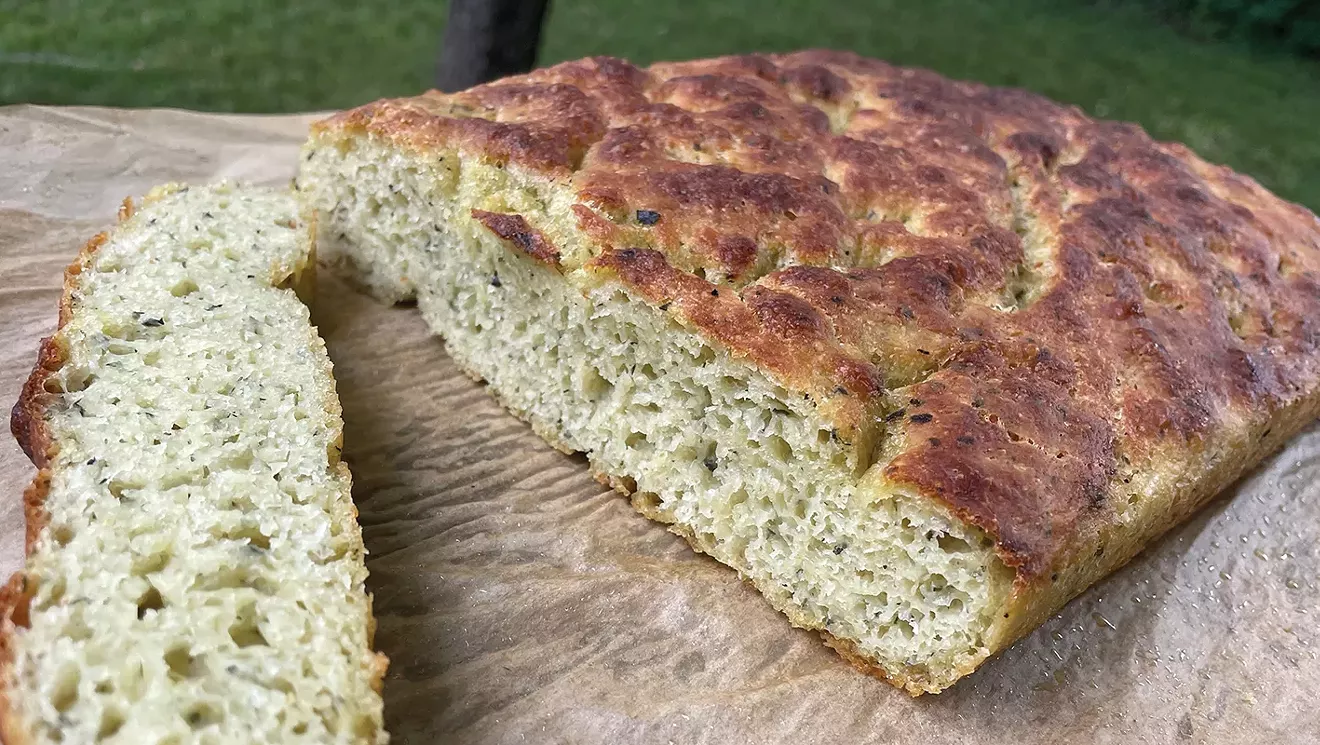
Photo by Ashley Meyer
Puréed zucchini can be used as the liquid component in zucchini focaccia.
Anyone who has grown zucchini in a garden will inevitably end up with a few mammoth squash that seemingly appear out of nowhere, especially after a generous dose of summer rain. Too tough and fibery to sauté or grill, I’d grate the first jumbo zucchinis of the season to use in quick breads, but toward the end of summer most of them would end up getting tossed out to the chickens because honestly, how many zucchini muffins can a person reasonably eat?
Then one day I had the crazy idea to use puréed zucchini instead of water in a batch of focaccia. Although I’m loath to turn on my oven in summer, I routinely make batch after batch of chewy, pillowy focaccia for grilled bruschetta and big-batch picnic sandwiches. If zucchini is 95 percent water, I wondered, could I get away with using it as the liquid component in bread? The answer turned out to be a resounding yes, and from that point on zucchini focaccia became my standard recipe year-round. In spite of my diligent efforts to harvest them when tender and small, I still end up with enough oversized zucchini to purée and freeze in recipe-ready portions to keep me baking bread until the following summer. The procedure is much the same as making a standard focaccia and the finished product has no discernible vegetable flavor or texture. While the raw dough is most definitely a vibrant shade of green, the color mostly bakes out with just little flecks of green remaining visible, reminiscent of savory herb bread.
Once the dough is made and in the pan, this bread becomes a further canvas for garden creativity. It can be kept simple with just a sprinkle of salt, or act as a base for a myriad of thinly sliced vegetables, grated cheese, herbs and berries or orchard fruit such as apples and pears. Raw vegetables such as zucchini (use small ones for topping), potatoes, peppers and onions should be sliced as thinly as possible and tossed with a teaspoon of salt and allowed to sit for at least 30 minutes (this can happen while the dough goes through its second rise) before being squeezed dry in a clean cloth in order to draw out excess moisture and prevent the bread from becoming soggy. Traditional, delicious topping combinations include grapes and fresh thyme, jalapenos and cheddar, zucchini and potato with herbs and cheese, bell peppers with onions and asiago, or pears with blue cheese and rosemary.
Zucchini focaccia
Ingredients:
1 jumbo zucchini
1 teaspoon sugar
1 packet (2 ¼ teaspoons) active dry yeast
5 cups bread or all-purpose flour (or use a mixture of white and whole wheat)
1 tablespoon salt
6 tablespoons olive oil (divided)
1 tablespoon butter
Flaky sea salt for sprinkling
Toppings, if desired, such as thinly sliced vegetables, cheese, herbs, salami and/or fruit
If the zucchini is quite large with mature, hard seeds, scoop them out and discard. Chop the zucchini into large chunks and purée in a food processor. You can also grate the zucchini on the large holes of a box grater. Measure out 24 ounces of the zucchini puree and transfer to a mixing bowl. Any remaining purée can be frozen in zip-top freezer bags for future use.
Mix in the sugar and yeast and let rest for five minutes to proof the yeast (the mixture will become foamy, indicating a healthy, active ferment) and allow the sugar to draw the water out of the zucchini. Add the flour and salt. Mix with a rubber spatula to create a loose, shaggy dough with no remaining streaks of flour. Pour four tablespoons of the olive oil into a large bowl and swirl it to coat the sides of the bowl. Transfer the dough into the bowl with oil. With clean, oiled hands, pick up the dough and fold it over onto itself two to three times to gently incorporate the oil into the dough. Cover and let rise until doubled in size – about three hours at room temperature or in the fridge for eight to 24 hours. The longer and slower the rise, the more flavorful the finished bread will be.
This bread can be baked in a 9-by-13-inch baking dish or in a rimmed 13-by-18-inch baking sheet. The former will result in a thick, pillowy bread ideal for sandwiches, while the baking sheet will create a thinner, chewier bread perfect for nibbling. Generously butter your pan of choice to prevent the dough from sticking.
Pour the remaining two tablespoons of oil over the dough, and using oiled hands, once again fold the dough over itself two to three times to gently deflate the dough. Tip the dough into the prepared pan and use oiled fingers to push the dough into the corners of the pan. Cover and let rise for 90 minutes and up to three hours, depending on the ambient temperature. The warmer the temperature, the faster it will rise.
About 30 minutes before baking, preheat the oven to 450 degrees F. Uncover the dough and use oiled fingers to create deep dimples in the dough. Arrange toppings over the dough if using (Be generous as the toppings will shrink while baking.) Sprinkle with coarse salt if desired, then transfer the dough to the preheated oven and bake for 20-30 minutes, until puffed and golden brown. Focaccia with lots of vegetable toppings will take closer to 30 minutes – keep an eye on it and reduce the heat to 425 degrees F halfway through baking if the toppings begin to get too brown. Let the bread rest five minutes after removal from the oven, then turn the bread out onto a rack over a baking sheet to cool. The baking sheet will catch any oil that may drip.


